Genre, Theme, Type & Solution Four Vital Elements in Reading Test of NMET[下学期]
文档属性
| 名称 | Genre, Theme, Type & Solution Four Vital Elements in Reading Test of NMET[下学期] |  | |
| 格式 | rar | ||
| 文件大小 | 14.2KB | ||
| 资源类型 | 教案 | ||
| 版本资源 | 通用版 | ||
| 科目 | 英语 | ||
| 更新时间 | 2007-04-08 23:03:00 | ||
图片预览

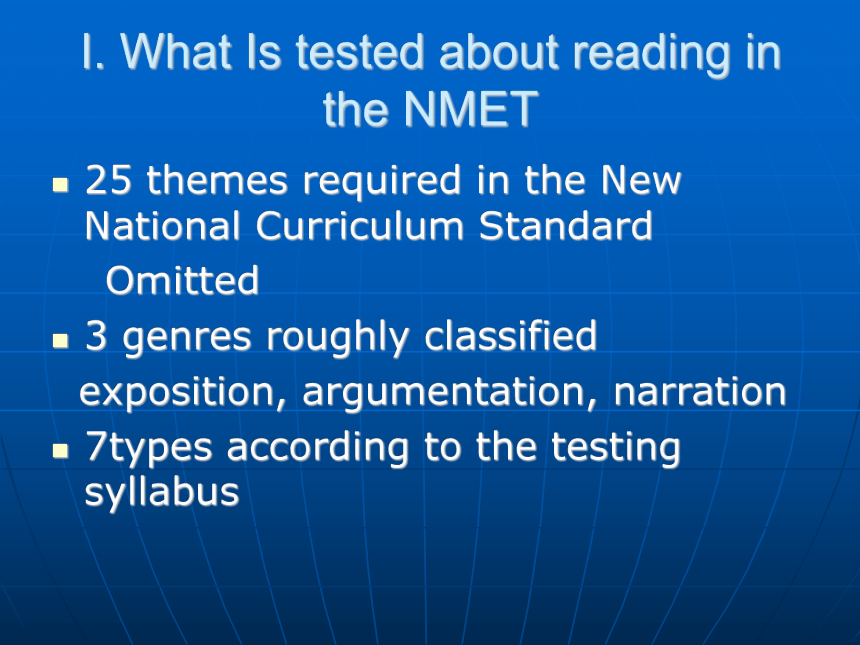
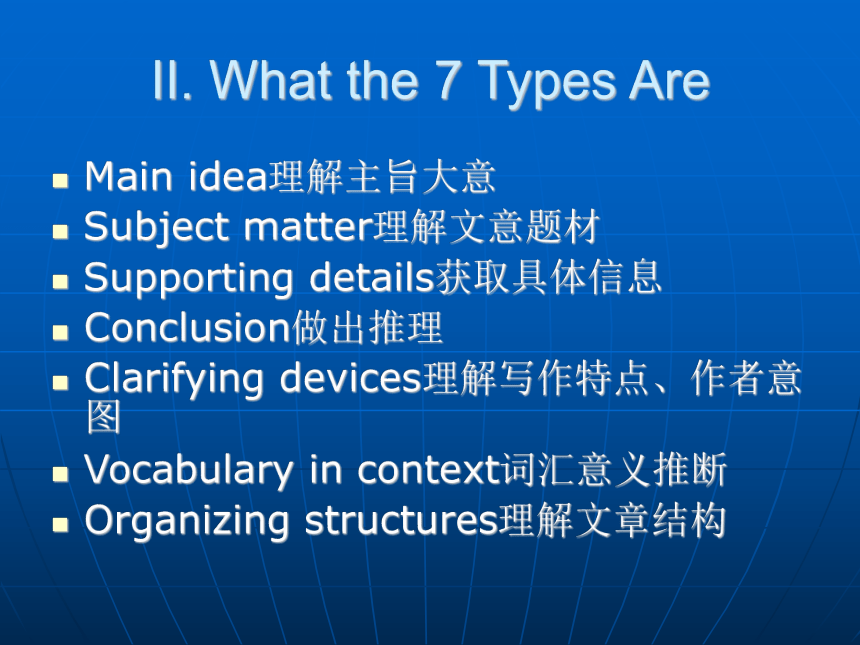
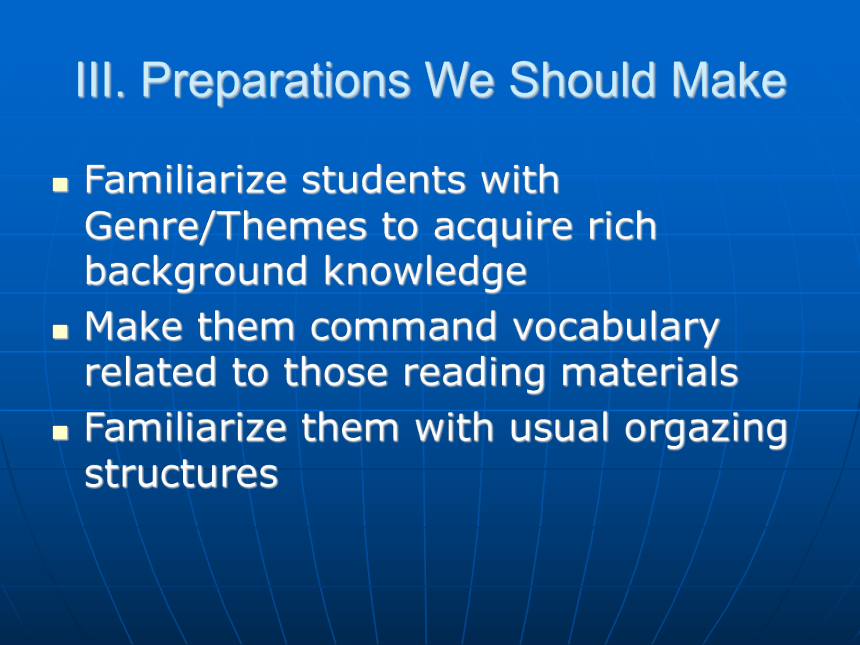
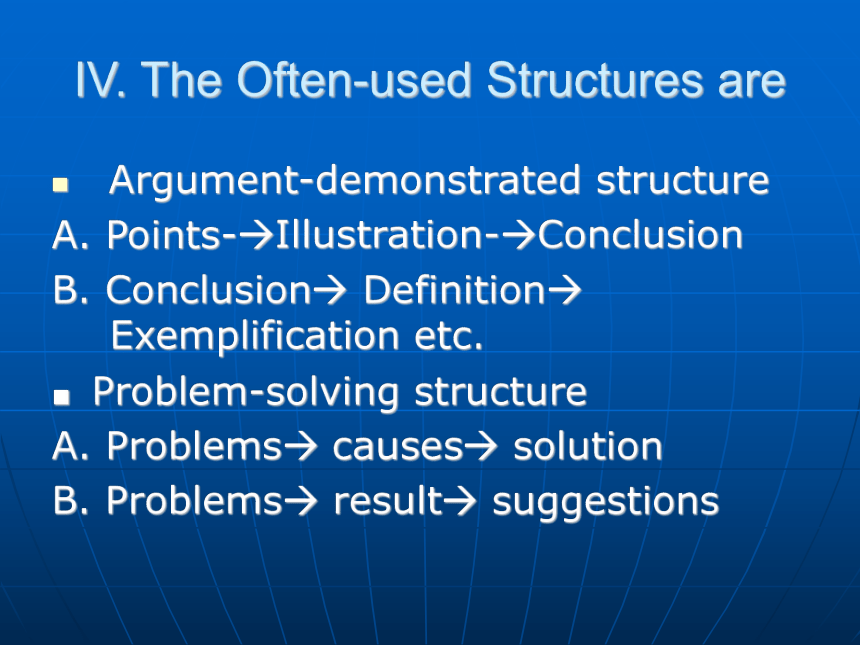
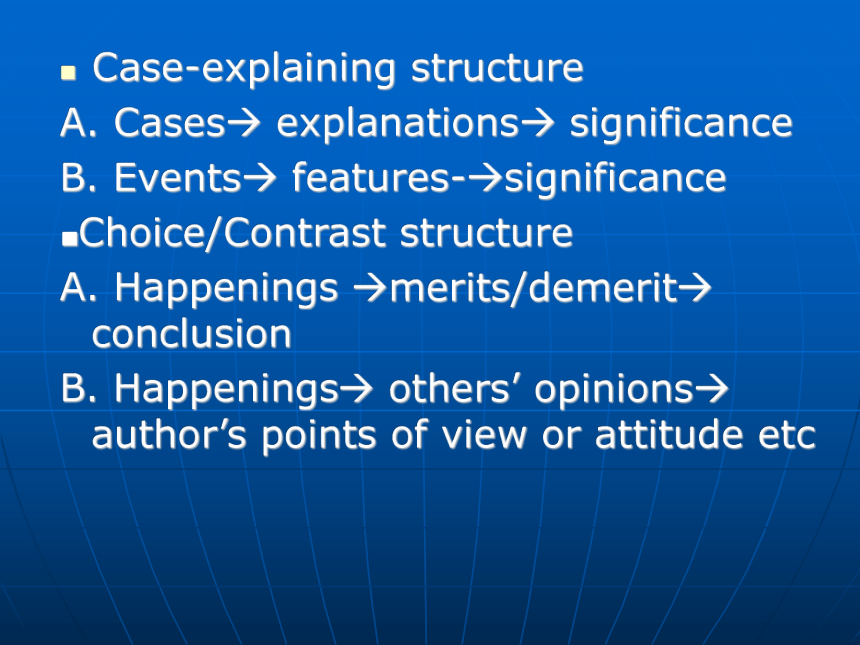
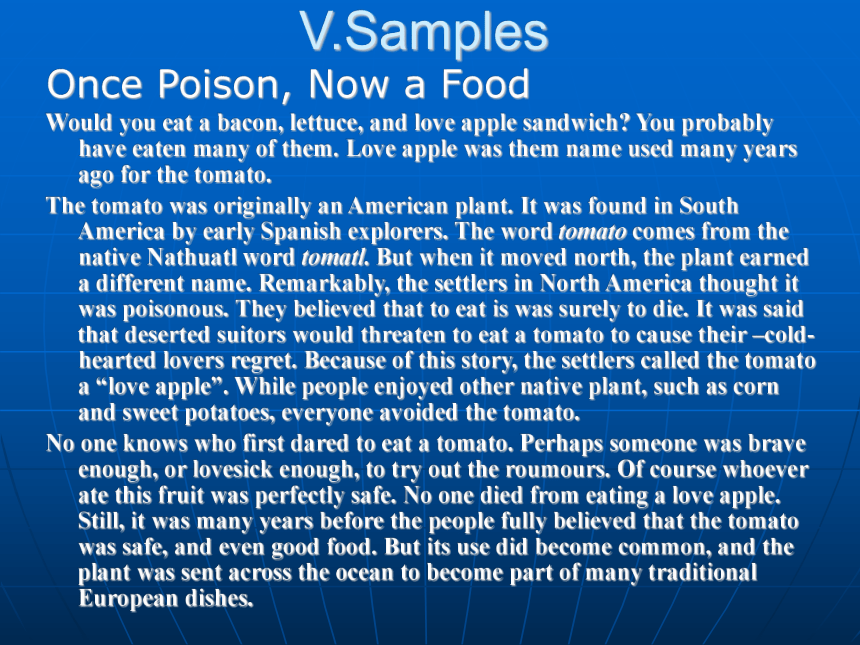
文档简介
课件15张PPT。Genre, Theme, Type & Solution
Four Vital Elements in Reading Test of NMETLiu Zhao-hui
lzhjyxy@yahoo.com.cn
Dec.16, 2006 Nan-jingI. What Is tested about reading in the NMET25 themes required in the New National Curriculum Standard
Omitted
3 genres roughly classified
exposition, argumentation, narration
7types according to the testing syllabus
II. What the 7 Types Are Main idea理解主旨大意
Subject matter理解文意题材
Supporting details获取具体信息
Conclusion做出推理
Clarifying devices理解写作特点、作者意图
Vocabulary in context词汇意义推断
Organizing structures理解文章结构III. Preparations We Should MakeFamiliarize students with Genre/Themes to acquire rich background knowledge
Make them command vocabulary related to those reading materials
Familiarize them with usual orgazing structures IV. The Often-used Structures areArgument-demonstrated structure
A. Points-?Illustration-?Conclusion
B. Conclusion? Definition? Exemplification etc.
■ Problem-solving structure
A. Problems? causes? solution
B. Problems? result? suggestions
Case-explaining structure
A. Cases? explanations? significance
B. Events? features-?significance
■Choice/Contrast structure
A. Happenings ?merits/demerit? conclusion
B. Happenings? others’ opinions? author’s points of view or attitude etcV.SamplesOnce Poison, Now a Food
Would you eat a bacon, lettuce, and love apple sandwich? You probably have eaten many of them. Love apple was them name used many years ago for the tomato.
The tomato was originally an American plant. It was found in South America by early Spanish explorers. The word tomato comes from the native Nathuatl word tomatl. But when it moved north, the plant earned a different name. Remarkably, the settlers in North America thought it was poisonous. They believed that to eat is was surely to die. It was said that deserted suitors would threaten to eat a tomato to cause their –cold-hearted lovers regret. Because of this story, the settlers called the tomato a “love apple”. While people enjoyed other native plant, such as corn and sweet potatoes, everyone avoided the tomato.
No one knows who first dared to eat a tomato. Perhaps someone was brave enough, or lovesick enough, to try out the roumours. Of course whoever ate this fruit was perfectly safe. No one died from eating a love apple. Still, it was many years before the people fully believed that the tomato was safe, and even good food. But its use did become common, and the plant was sent across the ocean to become part of many traditional European dishes.1. Main Idea:
Mark the main idea---M
Mark the statement that is too broad---B
Mark the statement that is too narrow---N
( )a. Many foods have legends associated with them
( )b. Although the tomato was thought to be poisonous, no one dies from eating it.
( )c. Long ago the tomato was called a “love apple” and was thought to be poisonous.2. Subject Matter
Another good title for this passage would be
( )a. Life in Early America
( )b. What Happens to the Brokenhearted
( )C. The History of the Tomato
( )d. Vegetables in Our DietSupporting Details3. The language from which we had the word tomato is
( )a. Portuguese
( )b. Spanish
( )c. Nathuatl
( )d. EuropeanConclusion 4. The origin of the story about tomatoes being poisonous is
( )a. South America
( )b. deserted lovers
( )c. an early settler who ate a tomato and got ill.
( )d. unknownClarifying DevicesThe word “still” in the middle of the third paragraph tells you that
( )a. people continued to be careful of tomatoes
( )b. people became very quiet when speaking of tomatoes
( )c. the writer is pointing out similarities
( )d. the writer is not sure about the truth of the following statementVocabulary6. Suitor means
( )a. boyfriend or girlfriend
( )b. landlord
( )c. tailor
( )d. explorerVI. Trends in testing reading1.Guang-dong---Experiment
2. Inappropriateness—gap-filling based on listening
3. Acceptability—gap-filling based on reading
4. Stability of reading testing types
Failures of FT in other items’ typesThanksAny Feedback is Welcome!
lzhjyxy@yahoo.com.cn
Dec.16, 2006 Nan-jingI. What Is tested about reading in the NMET25 themes required in the New National Curriculum Standard
Omitted
3 genres roughly classified
exposition, argumentation, narration
7types according to the testing syllabus
II. What the 7 Types Are Main idea理解主旨大意
Subject matter理解文意题材
Supporting details获取具体信息
Conclusion做出推理
Clarifying devices理解写作特点、作者意图
Vocabulary in context词汇意义推断
Organizing structures理解文章结构III. Preparations We Should MakeFamiliarize students with Genre/Themes to acquire rich background knowledge
Make them command vocabulary related to those reading materials
Familiarize them with usual orgazing structures IV. The Often-used Structures areArgument-demonstrated structure
A. Points-?Illustration-?Conclusion
B. Conclusion? Definition? Exemplification etc.
■ Problem-solving structure
A. Problems? causes? solution
B. Problems? result? suggestions
Case-explaining structure
A. Cases? explanations? significance
B. Events? features-?significance
■Choice/Contrast structure
A. Happenings ?merits/demerit? conclusion
B. Happenings? others’ opinions? author’s points of view or attitude etcV.SamplesOnce Poison, Now a Food
Would you eat a bacon, lettuce, and love apple sandwich? You probably have eaten many of them. Love apple was them name used many years ago for the tomato.
The tomato was originally an American plant. It was found in South America by early Spanish explorers. The word tomato comes from the native Nathuatl word tomatl. But when it moved north, the plant earned a different name. Remarkably, the settlers in North America thought it was poisonous. They believed that to eat is was surely to die. It was said that deserted suitors would threaten to eat a tomato to cause their –cold-hearted lovers regret. Because of this story, the settlers called the tomato a “love apple”. While people enjoyed other native plant, such as corn and sweet potatoes, everyone avoided the tomato.
No one knows who first dared to eat a tomato. Perhaps someone was brave enough, or lovesick enough, to try out the roumours. Of course whoever ate this fruit was perfectly safe. No one died from eating a love apple. Still, it was many years before the people fully believed that the tomato was safe, and even good food. But its use did become common, and the plant was sent across the ocean to become part of many traditional European dishes.1. Main Idea:
Mark the main idea---M
Mark the statement that is too broad---B
Mark the statement that is too narrow---N
( )a. Many foods have legends associated with them
( )b. Although the tomato was thought to be poisonous, no one dies from eating it.
( )c. Long ago the tomato was called a “love apple” and was thought to be poisonous.2. Subject Matter
Another good title for this passage would be
( )a. Life in Early America
( )b. What Happens to the Brokenhearted
( )C. The History of the Tomato
( )d. Vegetables in Our DietSupporting Details3. The language from which we had the word tomato is
( )a. Portuguese
( )b. Spanish
( )c. Nathuatl
( )d. EuropeanConclusion 4. The origin of the story about tomatoes being poisonous is
( )a. South America
( )b. deserted lovers
( )c. an early settler who ate a tomato and got ill.
( )d. unknownClarifying DevicesThe word “still” in the middle of the third paragraph tells you that
( )a. people continued to be careful of tomatoes
( )b. people became very quiet when speaking of tomatoes
( )c. the writer is pointing out similarities
( )d. the writer is not sure about the truth of the following statementVocabulary6. Suitor means
( )a. boyfriend or girlfriend
( )b. landlord
( )c. tailor
( )d. explorerVI. Trends in testing reading1.Guang-dong---Experiment
2. Inappropriateness—gap-filling based on listening
3. Acceptability—gap-filling based on reading
4. Stability of reading testing types
Failures of FT in other items’ typesThanksAny Feedback is Welcome!
